Papua New Guinea. A forgotten tropical paradise. Colourful. Diverse. And with many parts completely untouched and totally native. It is a place of all colours and shapes in both flora and fauna. Thick, rough jungle, bright blossoms and above all the sound of singing birds of paradise. Sparse volcano slopes shine green and red, hot steam rises from the solidified lava like boiling fog. Papua New Guinea is a country of superlatives. It is not A destination, it is THE destination.
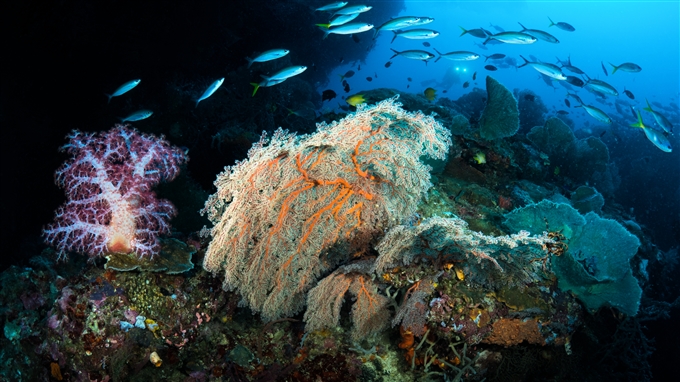
David Benz • E-M1 Mark II • M.Zuiko Digital ED 8mm f1.8 Fisheye PRO
• PT-EP14 • PPO-EP02
Still, it is often unheard of and far away to the minds of travelers. Mass tourism has not arrived here yet and it will probably be a while until it does. So, this country north of Australia does not only come with a warm breeze of the South Pacific but with a touch of risk and adventure. You need a real spirit of adventure and strong nerves to come here. Until the beginning of the 19th century cannibals and head hunters called this place home. Warriors called their ancestors, performed bloody rituals and played their drums in the darkest nights. When the darkness arrived, the hunting began. Armed to the teeth family clans would go into battle. Their victims were skinned and beheaded. Their flesh was eaten, their heads collected as trophies. And still today in the 21th century, in the times of western clothing and smartphones, Papua New Guinea is still a wild tropical island, a place carrying lots of riddles and secrets.
We get insights into a world where witch hunt and clan wars still exist. Rituals and tribal dances are not staged for tourists but they are a very real part of the everyday life on Papua New Guinea. Some village people still live like in primeval times, closely linked to nature. That’s why New Guinea is definitely not a typical travel destination. It is exotic and unknown – perfect for divers and photographers. In the dive resorts you can find optimal conditions for a perfect roundtrip from one dive spot to the next. Always by our side: the constant feeling of experiencing one of the world’s last adventures. Welcome to the world of clan warriors and crocodile men, home to the birds of paradise, fire-spitting volcanos and shark whisperers. Welcome to the last Garden of Eden.
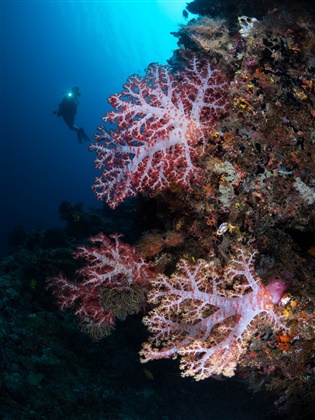 |
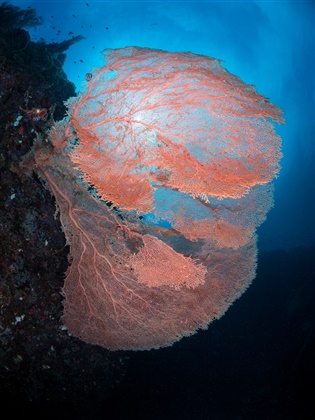 |
David Benz • E-M1 Mark II • M.Zuiko Digital ED 8mm f1.8 Fisheye PRO
• PT-EP14 • PPO-EP02
The journey to Papua New Guinea can take up to two days. Every change leaves you with a smaller plane. There are roads on Papua New Guinea, but nowhere near everywhere. Many parts are still covered by such a thick jungle that they cannot be reached without a plane. And it is that bird’s eye perspective that reveals the powerful and rich virginity of this country. Unlimited green. Endless vegetation. We discover deep valleys and impenetrable rain forests, glaciers and active volcanos. The intact coral reefs around the coast of the country are sparkling in every colour of the rainbow. Even as a widely travelled diving enthusiast and underwater photographer this is a revelation in green, blue and turquoise. The view from the plane towards the endless dive grounds makes us forget the long journey and we are curious and ready for the upcoming adventure. Slowly we are approaching the ground. Touch down. The door opens to a completely foreign and wild world. We have arrived. Somewhere in the middle of nowhere. We are greeted by extremely high humidity, the sounds of the jungle and the Kimbe Bay on New Britain, which is without doubt an absolute hotspot for divers and underwater photographers.
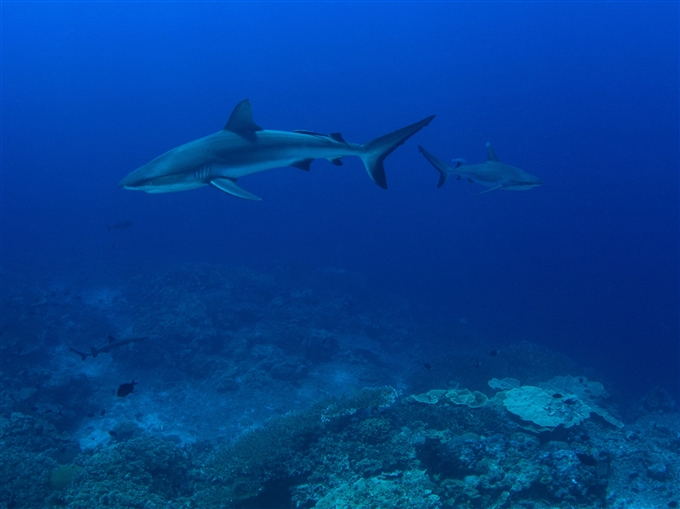
David Benz • E-M1 • M.Zuiko Digital ED 8mm f1.8
• PT-EP11 • PPO-EP02
The crystal-clear waters in the bay and the dive spots in front of them allows an undisturbed view of the beauties of the tropical islands of New Guinea. During our first dives at Kimbe Bay we experience an incomparable diversity of species. The surrounding reefs guarantee lots of big fish. The corresponding high concentration of sharks ensures your adrenaline levels stay up at all times. There is no dive without the sighting of grey sharks, blacktip or whitetip reef sharks. Large shoals of jackfish and barracudas make our diver hearts jump. At the dive spot Inglish Shoal we are surrounded by 8 sharks at once. But the presence of reef sharks does not mean that you can miss the hammer sharks that make their appearance from time to time. Majestically they are circling around the divers. We can only be amazed and make sure we get a good photo as proof.
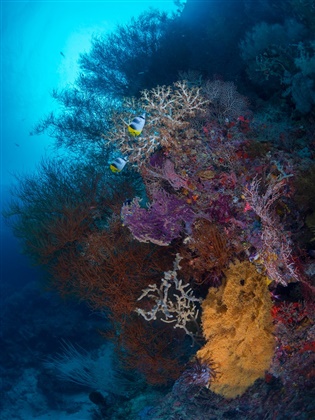 |
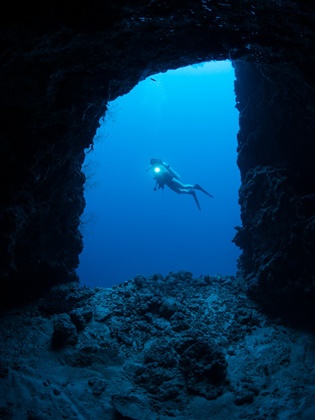 |
David Benz • E-M1 Mark II • M.Zuiko Digital ED 8mm f1.8 Fisheye PRO
• PT-EP14 • PPO-EP02
Jumping backwards into the blue we dive down to the next adventure at Susan’s Reef. Down at around 10 meters giant blocks of corals are making their way up from the blue, fire red whip corals and fine gorgonian branches appear. It is a complete bustle of shapes and structures. On top of the reefs you can find huge formations of corals side by side. For millions of years they have built coral mountains step by step. We are diving through reef passages, tunnels and overhangs. We are floating through colourful shining fields of hard and soft corals that serve us as a perfect backdrop for some wide-angle shots. A few orange anemone fish here, a shoal of sweetlips there and some juvenile barracudas over there – our memory card fills up more quickly than we would have imagined.
But not only divers will be highly satisfied here. The candy-bright and diverse flora and fauna of New Britain ensures the perfect adventure for everyone. On our tours we wander through rich green areas and enter huge butterfly gardens. At the foot of an active volcano we take a bath in the middle of the thick and impassable jungle. With water temperatures of 40°C this is not exactly a cool down but a once-in-a-lifetime spa experience – including the mud treatment.
After some extraordinary experiences we had at Kimbe Bay it is time to move towards new remote territories. You do not really need much to create your own little tropical paradise here. An island, a bungalow below some palm trees, white beaches and spectacular dive sites with water temperatures of around 30°C. Lissenung Island on New Ireland will provide you with this exact paradise. The unique location of this island is just perfect for diving. Surrounded by palm trees this magical place is situated between the open Pacific Ocean and the Bismarck Sea. It comes with rich tropical vegetation and crystal-clear waters. Who does not dream of something like that? With the sand between our toes, we are reminded of Robinson Crusoe.
We are diving deep into the blue of the Bismarck Sea. During our first dives it seems that the biodiversity of the flora and fauna underwater is just exploding at this place. Along the edge of the reef at the Albatros Passage we encounter the first black- and whitetip reef sharks slowly passing us. Colourful gorgonians and sponges stick to the rock formations. We are floating through a bright magical forest made of shapes and colours. All the time, we can discover new sorts of hard and soft corals. Sharp deer corals, complicated branches, table corals, small trees, gelatinous giant brains, mushrooms. We are diving through an endless vibrant garden.
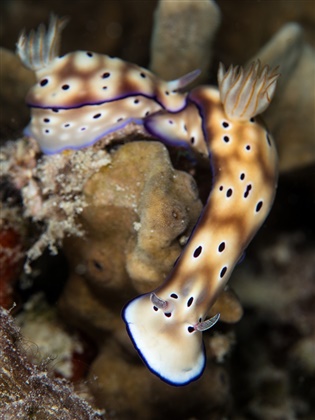 |
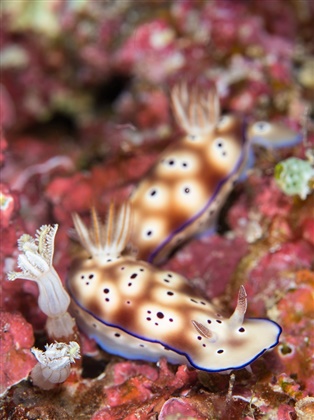 |
David Benz • E-M1 Mark II • M.Zuiko Digital ED 60mm f2.8 Macro
• PT-EP14 • PPO-EP02
The unique location of Lissenung Island and its surrounding dive spots created a real underwater wonderland. Strong currents that are caused by the change of tides make clear water from the bottom of the ocean come upwards through tight passages and along the reefs. And where there is a current, there will also be life. Sharks, tunas and huge shoals of barracudas and thorn mackerels follow this current. At the reef you will discover the diversity of the fauna by the motionlessness of the corals and the smooth movements of the passing turtles and mobula rays. We are diving through an oasis of life which is presenting itself in its full glory.
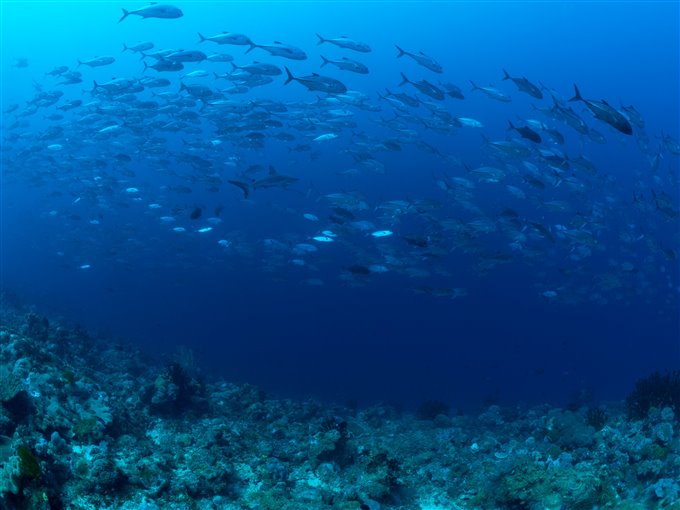
David Benz • E-M1 • M.Zuiko Digital ED 8mm f1.8 Fisheye PRO
• PT-EP11 • PPO-EP02
Without doubt, Matrix, Pete’s Patch and of course the Albatros Passage are correctly regarded as some of the very hotspots of the 42 dive spots around Lissenung Island. Exorbitant shoals of bat fish, barracudas and thorn mackerels are dominating the scenery here and impress us as much as the shark population. There is no dive without the sighting of a shark. Reef sharks keep on crossing the deep blue. Three majestically floating eagle rays are also circling around in the distance. Stuck to the rocks, gorgonians and colourful fans are softly swinging and waiting for the current to bring them their food. Due to the existing currents, most of the dive sites are ideal for drift diving. We are just drifting along the edge of the reef in the current. The course of the ocean takes our hand and moves us along gorgonians and fan corals, large and small houses. Tame, our dive guide, is signalling us to drop our reef hooks now to easily enjoy the hustle and bustle at the edge of the reef. The current becomes too strong – not only for us underwater photographers. Some relaxed photographers meet their limits here.
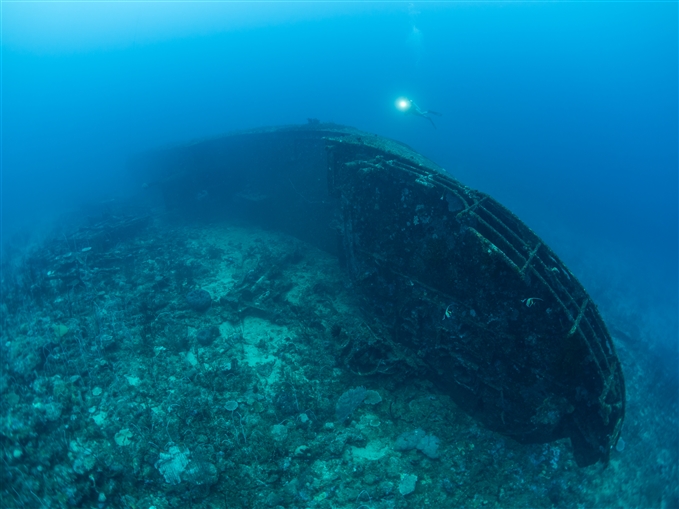
David Benz • E-M1 Mark II • M.Zuiko Digital ED 8mm f1.8 Fisheye PRO
• PT-EP14 • PPO-EP02
Besides the big fish one thing is definitely on the schedule in Papua New Guinea: wreck diving. During World War II Papua was the scene of long forgotten battle ships. So, countless ship wrecks and airplanes can be found today, some of them even very well preserved. These wrecks have become part of the fantastic underwater world and can be discovered by divers and photographers. From airplane wrecks in the shallow water to big ship wrecks deep down at 60 meters – there is something for everyone interested in wreck diving. We also want to literally dive into this country’s history and decide to discover a plane wreck near Kavieng harbor. We go up to 12 meters deep into the spooky wreck quietly lying at the bottom of the ocean. This old bunch of metal is now housing many fish and plants. We find countless critters and ludicrous little species and it seems you can find life in even the tiniest corner of the wreck. Gobies, shrimp, clown fish, colourful nudibranchs and ghostly feather stars are dominating the scenery. The current is hardly present and lets us enough time and opportunity to catch this mystical atmosphere around this plane wreck with our camera.
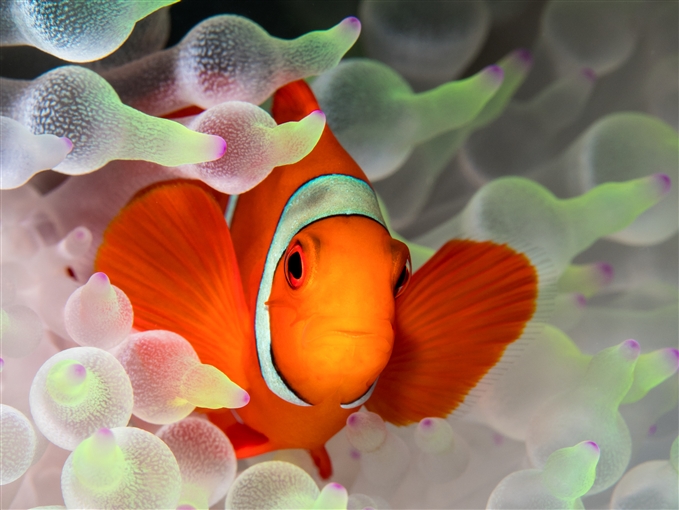
David Benz • E-M1 Mark II • M.Zuiko Digital ED 60mm f2.8 Macro
• PT-EP14 • PPO-EP02
Totally intoxicated by wreck diving we move on to the wreck The Yang in the afternoon. The Yang is a sunk Korean fishermen’s boat. We leave the world on the surface and dive down to the overgrown ground. The current is moving us smoothly along the wreck from the hull to the stern. An inquisitive turtle comes our way to eye us. We circle around the wreck. Once, twice, before our oxygen runs short and makes us ascent. But Lissenung Island does not only offer wrecks and big fish of all sorts. The dive spots aroung Kavieng provide divers with a huge diversity of microorganisms and critters proving that small things can indeed be great! Already at our house reef we get totally enchanted by the critters, snails and nudibranchs. A weird looking Orange Mantis Shrimp is waiting for us at around 3 meters deep. It is shining so bright that it seems to have risen straight from hell. Lionfish, shrimp and frogfish meet up underwater while a juvenile bright orange anemone fish is enjoying itself on a palm sized anemone. Nudibranchs of all possible shapes and colours are slowly creeping through the neighbourhood and cause some stunned diver faces. Weirdly shaped ornate ghost pipefish gather for a small underwater ballet and shrimp are smoothly swinging on the arms of the anemones. A candy pink leaf fish does not really want to be seen and still becomes the object of desire for us photographers. Funny little pygmy seahorses – not much bigger than a fingertip and perfectly camouflaged – present themselves in a thick fan coral. The biodiversity is so huge that we definitely have problems deciding on the right photo object. Bizarre creatures, a colorful zoo full of funny and extravagant life.
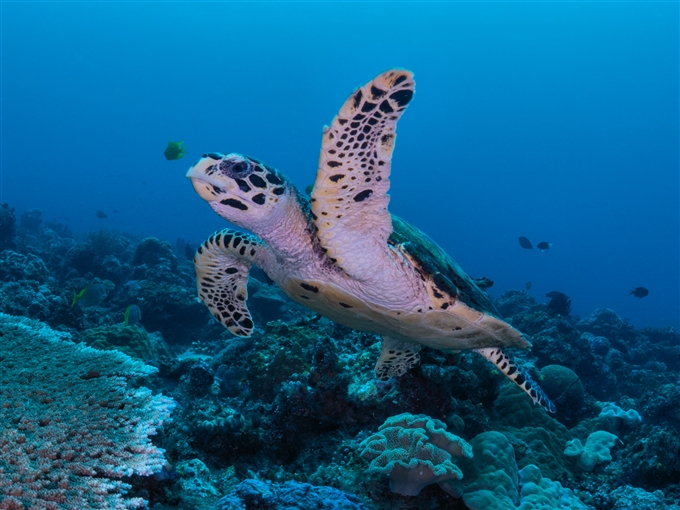
David Benz • E-M1 Mark II • M.Zuiko Digital ED 60mm f2.8 Macro • PT-EP14 • PPO-EP02
To us, Papua New Guinea stays the country of the unknown. Not only underwater. It offers an extraordinary and unique cultural diversity of tribes that live closely linked to their traditions. It is a country in which the modern way of life is still very far away. Everything proceeds in its usual and original way. Without stress. Nobody is rushed. Not even the animals. The diving experience plays the central role here. And what we take home is the adventure of experiencing a real paradise – both on the surface and underwater. A great adventure in the last Garden of Eden.
Comments
Show more comments (2)